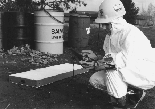


Researchers are speeding the commercialization and use of an innovative fiber-based sensor that can analyze soils for uranium and strontium contamination.
The sensor, known as BetaScint, was developed at Battelle's Pacific Northwest National Laboratory under funding from the U.S. Department of Energy's Office of Science and Technology. The device addresses the need for rapid, on-site detection of uranium-238 and strontium-90, two of the most prevalent radioactive contaminants left from nuclear power generation and weapons production.
John Nagy, health physicist with Nuclear Fuel Services of Irwin, Tennessee, said his company learned about BetaScint when PNNL approached NFS about demonstrating it. NFS is now considering using BetaScint in cleanup work resulting from the past production of nuclear fuel needed by DOE and commercial clients.
"We have a few million cubic feet of contaminated soil, covering about a third of the 60-acre site. We envision using BetaScint as a potential screening tool to tell us, as we dig up the soil, which areas are contaminated with uranium-238 and which are not. We would, of course, do verification later, but being able to roughly discriminate good from bad soil keeps you from shipping off uncontaminated soil and adding unnecessarily to the shipping and disposal costs. That's one reason that separations technologies are so critical," Nagy explained.
Demonstrations have been a strategic aspect of developing the technology for market use, said PNNL researcher Alan Schilk. "DOE's uranium in soils integrated demonstration at Fernald in 1994 gave us a good chance to define the parameters that maximize the potential of the instrument and identify other markets and potential clients."
 One
of BetaScint's main advantages over conventional methods is that
it is portable; it can be taken to the field to provide on-site
results within minutes. This eliminates the risk and expense of
transporting contaminated samples to an off-site laboratory,
where the waiting time for results may be weeks, and costs can
range from $100 to $200 per sample. Those costs are roughly two
to five times higher than using BetaScint.
One
of BetaScint's main advantages over conventional methods is that
it is portable; it can be taken to the field to provide on-site
results within minutes. This eliminates the risk and expense of
transporting contaminated samples to an off-site laboratory,
where the waiting time for results may be weeks, and costs can
range from $100 to $200 per sample. Those costs are roughly two
to five times higher than using BetaScint.
That was a selling point with DOE's Inhalation Toxicology Research Institute in Albuquerque, New Mexico, where project managers used BetaScint in a cleanup at a liquid waste storage area that was under a voluntary cleanup program. "This device is the first one of its kind that allows us to measure strontium-90 in real time," said Mark Hoover, ITRI aerosol scientist. "We did cross calibration with an off-site lab and the correlations were very good. Because you can get results quickly, you can avoid overexposure of individuals doing the cleanup, because you know right away if you've found a pocket of high concentration.
"It was a win-win situation," he continued. "We wanted to help PNNL commercialize the device and at the same time do a fast, safe job of remediating our site. The beauty of the DOE family is that we were able to enter into a partnership with another DOE entity and try out a new technology at very low cost and low risk."
Optimized for detecting contamination on the surface of soil, BetaScint is particularly well-suited for detecting strontium and uranium in soils downwind of nuclear processing plants to determine if they are operating in violation of a treaty. The International Atomic Energy Agency, which is responsible for nuclear non-proliferation treaty verification, has purchased a BetaScint device to enhance their ability to monitor nuclear activity around the world.
Other private-sector interest has been expressed by Thermo NUtech, an Albuquerque company that is considering using BetaScint in conjunction with a conveyor-belt soil sorting system equipped with radiation detectors. B.Koh and Associates, a small company in Maryland specializing in environmental restoration, is also interested in BetaScint.
B.Koh Vice President Ted Adams said BetaScint is a candidate for use at two Ohio sites where a uranium-based catalyst was used in the acrylonitrile plastics process. Each site is several acres in size, and BetaScint could offer tremendous advantages in the final survey work that is needed to confirm that soils have been cleaned up to NRC levels. "We're eager to get with the BetaScint people in the field so we can see its capabilities," Adams said.
Recognizing the promise of the technology and wishing to assist in its transfer, PNNL has given Schilk a small-company start-up loan. "We can either deploy the technology with qualified teams to companies doing remediation contract work, or we can lease it to companies after providing them with the necessary training," says Schilk. "Our goal is to get the instrument into the marketplace."
For more information about BetaScint demonstration results, see Sandia Report SAN-D96-0262, UC-814, 1994 Fernald Fuel Characterization by C. A. Rautman, February 1996. Or call Paul Kaplan at Sandia National Laboratory, (505) 848-0684, or visit BetaScint at http://www.betascint.com.
![]()